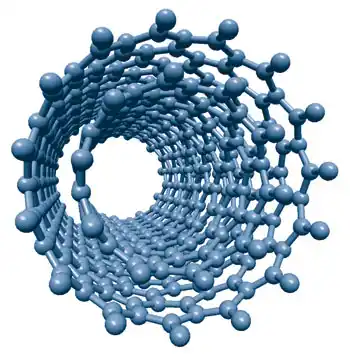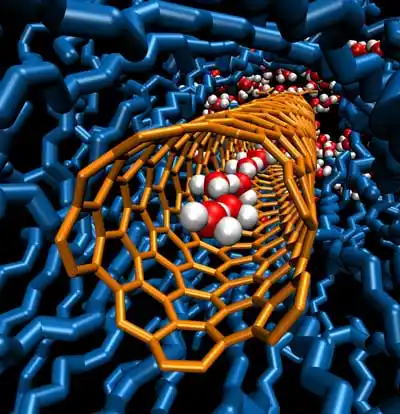افشین رشید
اُستادیار ؛ عضو هیات علمی دانشگاه آزاد اسلامی واحد علوم و تحقیقات تهران
615 یادداشت منتشر شدهSingle-walled nanotubes (CNTs) and efforts to replace them in the nanoelectronics industry, based on their excellent mechanical and electrical conductivity properties such as metals

Note: Single-walled carbon nanotubes, or CNTs, can be very conductive or semiconductor. This high electrical conductivity depends on the exact geometry of the carbon atoms. Single-walled carbon nanotubes, or CNTs, are referred to as a one-dimensional phenomenon.
The reason for the interest in these single-walled nanotubes (CNT) and the attempt to replace them in the industry is based on their excellent mechanical properties and electrical conductivity like metals. Of course, the production of single-walled nanotubes has a high cost and production It is difficult to stabilize their properties during the processing of nanotube polymers. Although nanotubes are manufactured using a technique that involves horizontal and vertical movements, in addition to being kept stationary, they are structurally controllable.

One of the disadvantages of multi-walled nanotubes compared to single-walled is that their strength is lower because the joints of the inner plates are weak. However, since the current applications of CNT single-layer nanotubes in the amplification of electrical transmission line devices improve thermal and electrical properties to improve the mechanical properties and application of multi-walled carbon nanotubes or CNTs is very high. On the other hand, the existing techniques are not efficient enough to produce single-walled nanotubes and do not bring the necessary purity. Purification of these materials is very laborious and may ultimately damage the electrically conductive structure of CNT single-walled carbon nanotubes. CNT carbon nanotubes according to their geometric shape and single layer carbon nanotubes according to how their graphite plates are rolled into conductive or semiconductor in Coming. In other words, because the nanotubes appear at the molecular level as an intertwined wire beam, the carbon atoms are connected in a hexagonal pattern, forming hexagonal cylindrical walls that are only a few nanometers in size. . The torsion angle of a nanotube, defined as the angle between the axis of its hexagonal pattern and the axis of the tube, determines whether it is conductive or non-conductive. Changing the radius also makes it possible to close the band length and insulate the metal nanotube. So we can say that two basic parameters that play a key role in this , one is the structure of the nanotube and the other is its diameter and size. In electrical conductivity from a conductor to a semiconductor or an electrically changeable insulator of nanotubes depending on their structure and molecular chiral angle . Because carbon nanotubes are able to pass electric current through their surface by frictional electron ballistic transfer - this current is 100 times greater than the current passing through copper wire - so nanotubes are an ideal choice for many applications. Are microelectronics.
Note: Layers of nanotubes can behave like a metal and be electrically angled. Structure and structure changes in them can display semiconductor properties. Or be non-conducting. For example, a slight change in the helix can turn a pipe from a metal to a semiconductor with a large gap.
Carbon nanotubes are hollow cylinders composed of carbon atoms in a hexagonal structure. Two common zigzag and armature structures with various geometric and behavioral characteristics are studied to evaluate the effect of structure type on changes in mechanical properties, the most important of which is the modulus of elasticity. These two widely used structures in the present study have been modeled by finite element method in Mark analyst software and the effect of changing the appearance of the carbon nanotube structure on its modulus of elasticity has been studied. The behavior of covalent bonds between carbon atoms is assumed by assuming bending elements with modulus of elasticity and a certain Poisson's ratio and applying a net tensile load to its upper surface to calculate the amount of modulus of elasticity of the structures under study. According to studies, the armature structure has a higher modulus of elasticity compared to zigzag specimens.

So that zigzag specimens always tend to increase their modulus of elasticity and reach the corresponding value corresponding to the ideal structure of the armature. The direction of rolling up (rolling or chiral vector) of graphene layers determines the change in electrical properties of nanotubes. Chirality describes the hexagonal lattice angle of a carbon nanotube. Nano seat tubes - so-called because of the shape of the seat like their edges - have the same chiral indexes and are highly desirable for their complete guidance. They are not unlike zigzag nanotubes , which may be semiconductors. Converting a 30-degree graphene sheet changes the nanotube that changes from chair to chair or zigzag or vice versa.

While MWCNTs always reach and reach at least the same level of conductivity of metals, the conductivity of SWCNTs depends on their chiral vector. The properties of carbon nanotubes are not the same.At present, SWCNTs are prepared by various techniques such as arc discharge, hydrocarbon pyrolysis in the presence of catalyst, laser evaporation and chemical vapor deposition. , Spring-like and spiral. Existence of different structures expands the properties and applications of SWCNTs, but newly synthesized SWCNTs contain many different nanotubes, which is the main obstacle to their use in high-efficiency nano-equipment. It has been shown that the physical and electronic properties of a SWNT depend on the diameter of the tube and its structure (m, n). In most applications, we need nanotubes with the same properties. Example The performance of a CNT-based nanoelectronic device is significantly improved by using the same nanotubes. Field effect transistors with on / off ratios of 106, using carbon nanotubes enriched with (5,